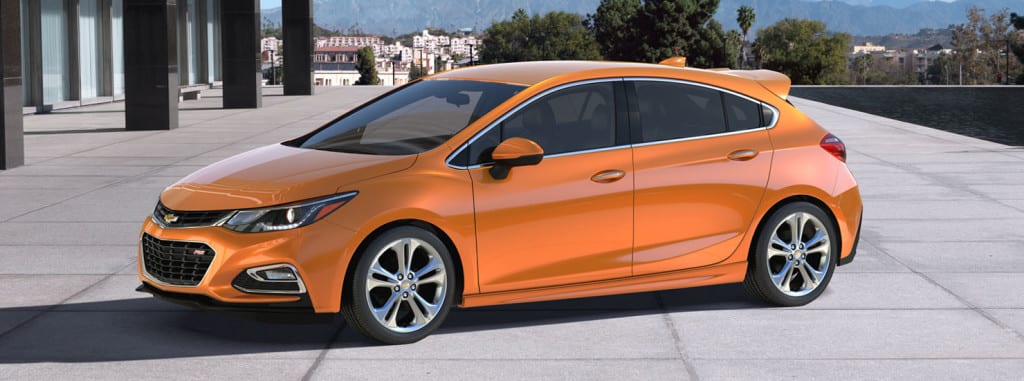Not much has changed for the 2016 Chevy Cruze since the first model originally went on sale in America. There may have been a few tweaks and upgrades here and there, but overall it’s remained relatively untouched. In the fall of 2016 though, that’s about to change. Meet the latest Cruze to be introduced by Chevy: the Hatchback. Since hatchbacks are so popular right now, it’s a smart move for Chevy to release their own version for its global bestseller. Don’t worry, the sedan version will still be kicking around, with all the features and capability you know and love about it.
Let’s take a look at this new kind of Cruze that’s ready for the coming fall season, and check out what sets it apart from the current sedan model.
New Model, Same Base
When the Cruze Hatch is released next fall, it’s going to join the Colorado and Trax as the latest Chevy vehicle to push into new frontiers on the market. Backed by the popularity of the Cruze sedan, Chevy is hoping this new Hatch will become just as popular. Because of this, Chevy made sure the new Hatch is characterized by three key details: sporty appearance, functional reliability and increased cargo space.
Since the design is different on the Hatch, it only makes sense that the architecture of the vehicle had to change. But, even with a different architecture, the Cruze Hatch will still have the same class-leading 106.3-inch wheelbase as the sedan model, along with all the same great technology, fuel-efficiency, and spritely performance associated with current Cruze models.
Structural Changes
The Cruze Hatch will be sitting on a more rigid and lighter architecture than the sedan model. This lighter architecture is the whole foundation for a new type of driving experience, while simultaneously focusing on making the Hatch as safe and fuel-friendly as possible. In total, it’s 200 pounds lighter than the current model, mainly thanks to the new body structure that’s 100 pounds lighter, and an engine that shed 44 pounds.
This new structure is why the Cruze Hatch is a functional vehicle. Without creating a lighter frame, it would have been hard to keep it as fuel-efficient as the sedan model, and still add more cargo space and extra room.
Functional Design
Hatchbacks are tricky to design; they need to be built with increased cargo room as the goal, but still be aerodynamic and small enough so a fuel-conscious engine can effectively push it down the road. It’s even more of a conundrum for the Cruze Hatch, because Chevy wanted it to keep that same compact design, but still make it bigger for more room. Therein lies the conundrum: how do you keep something the same size, but also make it bigger? The answer to that is the new, lighter structure that was just mentioned — along with a boatload of engineering ingenuity.
Along with plenty of cargo space, the Hatch also has two more inches of legroom than the Ford Focus and Hyundai Elantra, both of which are popular Hatchbacks on the market. For cargo space behind the rear seat, the Hatch is able to offer 22.7 cubic-feet of cargo space. With the rear seats folded down, the cargo space will expand to 47.2 cubic feet, which is pretty darn impressive for a compact Hatchback.
In addition to increased cargo space, Chevy was also able to keep the Hatch fuel-efficient, thanks to its lighter structure and aerodynamic design. Overall, it’s successful and also gets props for being one of the better looking Hatchbacks on the market.
Sporty Look
It’s not often I say that I like the look of a Hatchback. But, I like this one. The Cruze Hatch looks sportier than the sedan, even though it has keep the sedan’s front design. Although your eyes are immediately drawn to that eye-catching front-end, past the windshield it’s a whole different world.
Instead of the typical sedan curve, it’s a shallow taper to the top of the back-end, where the roof meets a spoiler that’s thrown on to help with the aerodynamic and sporty nature of the Hatch. After it hits the spoiler, it’s a curving drop down to the bumper, which is then sucked in to the back of the rear tires. This curve causes the back to bulge a little bit, which gives it some muscular definition. Matching that bulge are the quarter-panels over the back wheels, which are a little thicker than those on the sedan model. The taillights are also different than the ones on the sedan, and they stick out from the back defiantly as a final declaration of the hatchback’s unique presence.
Overall, the Cruze Hatch looks more muscular and sportier than most hatchbacks on the market. Compared to the sedan model, it’s poses a more powerful stance, thanks to the unhindered muscle that runs rampant over its back. In order to make it even more rally car ready, the LT and Premier trims will feature an available RS package — similar to the RS package on the 2016 sedan model.
Lighter Turbo
A lighter engine means increased performance and better fuel economy. Expect to find the 1.4-liter turbo engine with direct injection, stop/start technology, and electric power steering standard across the Cruze trim levels again. Also, the Z-link rear suspension is back, and will be equipped with features from the Premier trim level. This suspension provides a more balanced driving experience because the Z-link rear suspension is able to better follow the direction of the front suspension.
At this time, are there any performance changes under the hood? None that we are aware of – at least for the moment. Would it be a bad thing if Chevy did add something for the Hatch? No, but it’s not necessary. The Hatch’s structure is already 100 pounds lighter than the current one and the Hatch kept the same wheelbase. Even without a lighter structure, the 2016 Cruze sedan is still able to snag around an eight second 0-60 mph time.
It might even be smarter for Chevy to leave the same engine that returns up to 42 mpg highway for the sedan model in the Hatch, and let the lowered structural weight improve the overall performance. That way, the Hatch can effectively provide a blend of power and efficiency.
The Rest is Similar
Apart from a lighter structure, new design, and lighter engine, there isn’t much else different about the Hatch that we currently know. All the same safety features from the 2016 Cruze sedan come standard or as available options, like Lane Keep Assist, Rear Cross Traffic Alert, Side Blind Zone Alert, etc. The technology from the current sedan carried over as well, and the Hatch will have segment-exclusive (and standard) Apple CarPlay and Android Auto compatibility via the MyLink radio system and available 4G LTE with a Wi-Fi hotspot. But, why try to change something if it works? The technology, performance, fuel economy, and safety of the current Cruze have won the hearts of buyers around the globe. So, it only makes sense to take those beloved qualities and bestow them upon the Hatch.
The Cruze is Chevrolet’s best selling car around the world, with 3.5-million sold since it first went on sale in 2008. 35 percent of Cruze customers are new to Chevrolet, and it’s the segment’s second-best seller to customers under 25. Based on these statistics, and the popularity of Hatchbacks, I think it’s safe to say the Cruze Hatch will be a huge success when it arrives on showrooms next fall.







